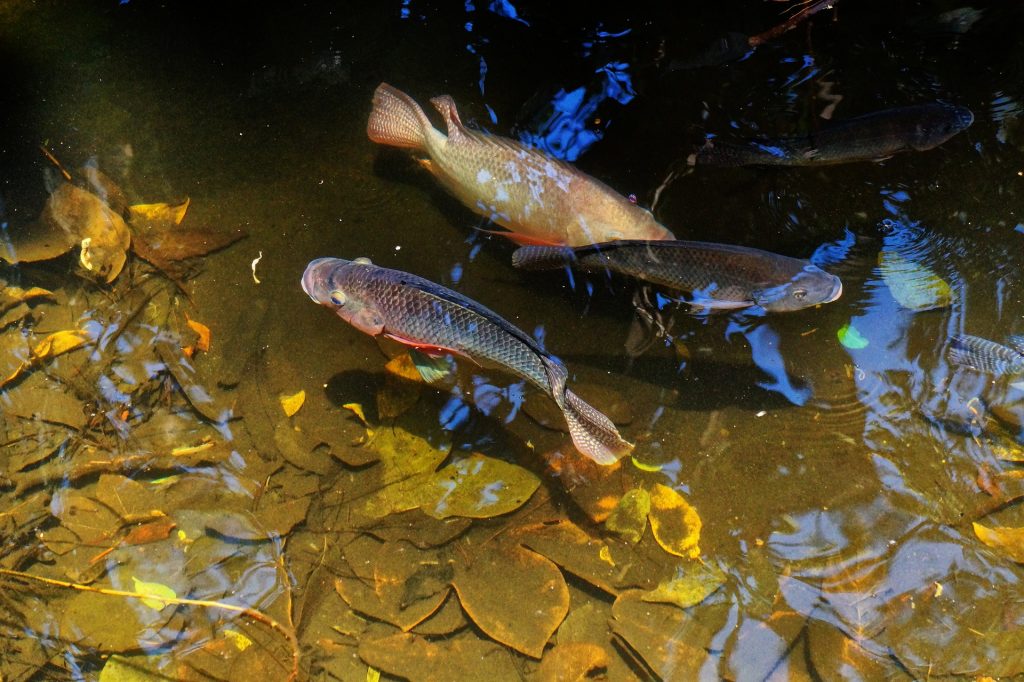Stocking Your Aquatic Wonderland: The Top 5 Pond Fish

Of all the potential outdoor features for the home, fish ponds are consistently popular. Balancing natural beauty with interactive fun, a pond provides enrichment for the whole family. There are many species of fish that can be kept in ponds, from intricately patterned koi to insectivorous sunfish to neat and tidy algae eaters. Selecting the right fish for your aesthetic and environmental needs is vital to the longevity and enjoyment of your pond. Here are the top five species of fish that will thrive in a pond – one is sure to be perfect for you!
Goldfish
Take a peek into any fish pond and you’re bound to see at least a few goldfish. They’re by far the most popular pond fish for many reasons – they’re vibrantly colored, easy to care for and fun to watch. Because they are easy to breed, there are many different varieties available, spanning a wide range of colors, patterns, fin types and sizes.
Goldfish have individual personalities that really shine when they live in groups; there are endless hours of entertainment to be had watching the antics of a school of goldfish. Hardy and adaptable to many different climate and water conditions, goldfish are a must-have for any outdoor pond.
Fathead Minnow
Many pond owners are concerned with the safety of their fish. Brightly-colored fish are beautiful to look at, but they are also highly visible to predators such as birds and cats. The fathead minnow strikes a great balance between beauty and safety. Its orange color, though not as saturated as that of a goldfish, is still quite striking.
Fathead minnows thrive in schools of up to twenty fish; large schools in particular are delightful to observe. They are quite resistant to disease and poor water quality, and they make a great option for smaller ponds due to their three inch maximum size.
Sturgeon
In contrast to the tiny, low-maintenance Fathead Minnow, the super-sized sturgeon provides a very rewarding challenge to those who are up to the task of its care. Bony in appearance, this captivating fish looks more like a dinosaur or a shark than a backyard pond inhabitant, but with proper conditions it will thrive in your pond for up to a hundred years!
Growing up to five feet long and weighing between 100 and 1000 pounds, the sturgeon’s size is overshadowed only by its personality. It is a joy to watch a sturgeon dig through the mud or bob up and down at the water’s surface in search of food. Despite their gargantuan size and carnivorous appetites, sturgeons coexist peacefully with other fish longer than two inches. Though they require a very large pond and careful monitoring of oxygen and water quality levels, sturgeons are a fascinating and unique choice for the ambitious pond owner.
Algae Eaters
Two types of algae eating fish are commonly kept in ponds; the right choice for you depends mainly on climate. Sub-tropical ponds make wonderful homes for Plecostomus fish, often called plecos. These fish are the stereotypical algae eaters, with large mouths on their undersides that suck up algae and detritus from the pond substrate. Though they scavenge for food, they still require regular feedings as they cannot survive on algae alone. When water temperatures drop below 55 degrees Fahrenheit, plecos must be moved to an aquarium or indoor pond.
Another algae eater, the high fin banded shark, is more suited to pond life in colder climates. It’s not a real shark, but its prominent fins certainly give it the appearance of one! Herbivorous and docile, the high fin banded shark grows up to three feet long and can tolerate water temperatures down to 40 degrees Fahrenheit. Unlike plecos, which are territorial and tend to prefer solitude, high fin banded sharks love to school with others of their kind, so they must be kept in groups of three or more.
Koi
Koi are the quintessential pond dwellers – large, vibrant and full of individual character. Spanning a rainbow of colors and a litany of patterns, koi are a type of carp, though many people mistakenly believe they are a variety of goldfish. They can be quite demanding to keep, requiring strong filtration and high quality food as well as a minimum pond size of 250 gallons per fish.
The payoff is well worth the effort, though. Koi can grow up to three feet long and live for 40 years or more. They are highly social and intelligent fish; they will quickly bond with their owner and learn to anticipate feedings. Keeping koi in a pond is a challenge, to be sure, but you’ll be rewarded with decades of beauty and joy from these special fish.

















